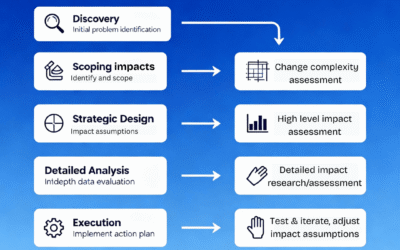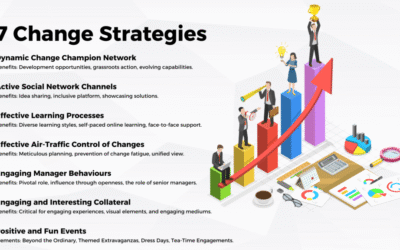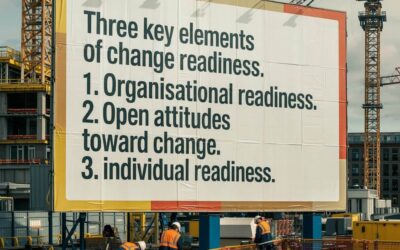In this Change Practitioner Q&A Series we interview change practitioners to find out more about how they approach their work.
A bit about Alvaro …
Alvaro is a change and program management professional, with experience in diverse industries, from Energy & Utilities, Education, Tech, Professional services, and Financial Services. He has worked across programs in transformation, technology, restructures, risk, regulatory, and culture.
Change Compass: Hi Alvaro, describe yourself in 3 sentences
Alvaro:
Personally, I tend to be cheerful and optimistic.
Professionally, I’m quite driven. I love to play a big part in complex pieces of work, being accountable for end-to-end delivery.
I like to “zoom in and out”. Diving into particular task detail, and also being clear of its value in the organisation, community, and society as a whole.
Change Compass: What has been the most challenging situation for you as a change practitioner? Tell us what happened and how you fared through it.
Alvaro:
The evolving nature of the change role and therefore the expectation on me as a practitioner. The definition of “change practitioner” is subjective across industries, teams, and projects; and thus, the “role” is not necessarily tied to a “title”. I’ve experienced this multiple times on projects.
Consider the overlap between the change analyst and business analyst roles, or between a change manager and a project manager. Since change management is not an isolated function, but rather is embedded across various teams, roles, activities, and artefacts (e.g., implementation plan), it’s not always easy to clarify roles and responsibilities. And this overlapping becomes more blurred when you add Agile ways of working/methodologies, product management, human-centred design, etc, which reminds me of The Change Compass articles on the role of Change Management in Agile.
These situations may be problematic if people in the team believe change management is an isolated function, or limit the practitioner to a particular methodology, potentially leading to “step on toes” situations – which I’m sure your readers are familiar with.
To overcome this, in the short term, I’ve spent time ensuring clarity of roles and responsibilities. Sometimes, this requires peer education on what change management is, which might even lead to some tough conversations. However, we should at least try to agree on common ground.
In the long-term (and I think we are heading there), industries, communities of practice, and professionals overall should move away from resourcing based on “titles” to evaluating “skills”. For example, rather than requesting a PM and a Change Lead, let’s think about the skills required for the management of such a piece vs the volume of expected effort.
Change Compass: What are the most critical and most useful things to focus on when you first start on a project, and why.
Alvaro:
I would say three things:
1) Data: From PMO/CMO, find out about the product, service, and industry… but to start, obtain an employee list with information on location, business areas, and roles. This will allow you to dissect the organisation to understand the complexity of each area, and how to best plan your engagement. All you need is the basic understanding of organisational design, and pivot table skills.
2) Governance: Change professionals are usually not accountable for this, but we should definitely be a part of it. It makes a difference when roles and responsibilities (from business sponsor to the intern), communication, and approval channels are clear. This includes agreed ways of working. I don’t mean unnecessary formal documentation or undesired and draining team-building workshops. A visual representation (accessible for contributors) with one or two conversations should suffice.
3) Project documentation as a product: Clear, honest, diligent, and accessible documentation on what you are working on, feeling comfortable to disclose the work in progress. If you treat your project documentation as a great product for your stakeholders (from the beginning), you’ll save a lot of time for them and yourself (and they will love you for it).
TIP: Look at the collaboration tools at the company. Some are better than others, I strongly recommend Confluence.
Change Compass: As change practitioners, we don’t often get to stick around to see the fruits of our labour, but from your experience what are the top factors in driving full change adoption?
Alvaro:
Discuss with your team and business owners the expected adoption and embedment outcomes from the beginning, including how they will be measured.
Include a decent timeframe within the implementation plan for adoption and embedment work (before and after Go Live). Do not squeeze this within “hyper-care”.
Understand the embedment systems at the organisation (if any). This may include existing forums, regular surveys, champions, and team leader/supervisor conversations within the business. Instead of creating “new” sessions, you can agree with the business to leverage these.
Adoption & embedment documentation tends to be a “tick the box” exercise. Those supervising change within organisations need to be more outcome-oriented, rather than auditors (checking if the change manager completed “x” or “y” artefact). This will promote a focus on the quality of delivery, over a focus on the completion of documentation. For change managers, it means moving from “I’ve done the embedment plan” to “I’ve co-designed an embedment plan with the stakeholders”.
Change Compass: You’ve been known as great at managing tough stakeholders. What’s your secret?
Alvaro:
The honest yet boring side of it is that I actually enjoy conflict resolution. Years back, I used to work at a restaurant and my peers would always ask me to resolve a situation with a tough customer. It doesn’t sound like helpful advice, right? Well, I guess my take is: practice conflict resolution! You may understand it but it gets better with experience. Other things are:
• Empathy: You never talk to a “title” (e.g., Executive Manager), they are a person, with a life behind their job.
• Transparency: Don’t play politics… it’s 2022 at the time of this article. Be yourself and say what and how things are.
• Vulnerability: Geez! This one is so important. Admitting you (or what you represent) might be wrong (or can be better) is extremely powerful. Build trust by being human.
Change Compass: If you could alter the change management practice for the better, what would you want to see happen?
Alvaro:
I would love to see a focus on skills, not titles or fixed “change methodologies”. This also includes seeing change as embedded across roles, artifacts, and activities, not as an isolated function.
Skills for a change practitioner must include strong project management, as well as data analysis to drive decisions in engagement, overall timing, and measurement. This includes companies using integrated tools to understand change across the organisation, as well as change practitioners understanding how to leverage them.
Finally, change management institutions and communities of practice must push to better integrate change management within project management methodologies. For example, as part of Prince 2 or Safe Scrum. There’s no need for a “change role”, but many aspects are missed (or unclear).






